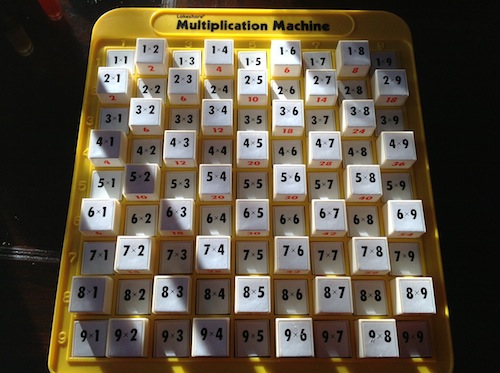Tabitha (6 years old) has been playing with the multiplication machine off and on for a few months now. We have never once used it for learning multiplication facts, but we have had a ton of math-learning fun with it.
Recently, she carefully did an up-down-up-down pattern that she continued along all of the columns.
We discussed her patterning a bit before I sent her upstairs for her bath.
I followed behind and, when I knew the machine was out of reach, asked her a question.
Me: You know how some buttons are up and some are down right now? Are there more ups or more downs?
Tabitha (6 years old): There are the same amount.
This was the answer I expected. As we will see, her reason for the answer surprised me.
Me: How do you know?
T: I did two patterns. Up down up down… and Down up down up. Let me show you.
We head downstairs together.
Me: OK. In this one column [I point to the first column on the left], are there more ups or downs?
T: [She counts each type] Downs. But in this one [the next column to the right] there’s more ups.
Me: So how about the whole thing?
T: Same!
Wait.
I’m gonna figure this out.
1,1,2,2,3,3,4,4,5
There’s more downs.
Me: How do you know?
T: Watch. [She points to columns as she counts, one column for each number word] 1, 1, 2, 2, 3, 3, 4, 4, 5.
Me: Right. But what does that mean?
T: One. There’s more downs. Then one. There’s more ups. Then two, and two, like that. But five is more downs.
Me: Wait. One has more downs, then the other one has more ups. So together the 1s have the same number of ups as downs?
T: Yeah.
Me: So then what?
T: Same for the 2s and 3s and 4s. But 5 has more downs.
Me: So there are more downs total.
T: Yeah.
Me: I have a challenge for you. If you can, try to make a pattern that has the same number of ups as downs. But not now. Now you have to get in the bath.
(to be continued)
So what do we learn?
We have to keep an open mind when our kids are telling us what they think.
I knew there were more downs than ups because we started with a down in the upper left. Moving across the row, there is an up for each down. The last down at the end of the row has an up at the beginning of the next row.
Every down has an up.
Except for the bottom right corner. That down has no up to pair with. So there are more downs than ups.
This is not at all how Tabitha saw it. She made groups—each column has an extra up or an extra down. Then she grouped these groups—each pair of columns has equal downs and ups.
By keeping an open mind, I was able to listen to her thinking. This let me ask follow up questions, which helped Tabitha make her own thinking better and more clear. I try as much as possible to have explain your answer be about convincing each other of something. You think they’re the same? Convince me. You think there are more downs? Convince me.
Starting the conversation
Patterns. Notice them. Play with them. Ask about them.
Any repeating pattern will do.
Even if the pattern had been Down down up, down down up (i.e. two downs for every up), we would have had a lovely conversation about which there were more of. The keys to the thinking in this pattern were:
- There were too many things for counting to be a convenient solution, and
- We started thinking about it when we didn’t have the machine in front of us.
I would have been content if Tabitha had counted 41 downs and 40 ups. But I was very much hoping to push her to use the pattern she had created to reason rather than to count.

